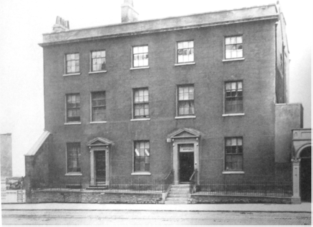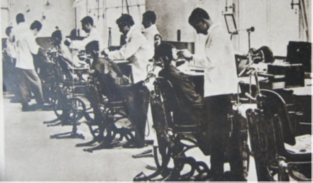It is easy to forget that over a hundred years ago the idea of women wanting to study dentistry, was not only unconventional but also out of the ordinary. Dr George Baker, a dentist writing in response to the idea of women being allowed to enter the profession in the 1860s, proclaimed the position that women shouldn’t be admitted to the profession because women did not possess the “mental and physical equipment of the highest order” [1] to become dentists.
The University College of Bristol opened it modest doors in October 1876 located in two houses in Park Street and was the first higher educational establishment in England to admit women on a basis of equality with men.
The first dental lectures were held in 1878. For clinical experience, the student attended either the Bristol Royal Infirmary or the General Hospital, to whichever they were allotted, on the days when the Dental Surgeons were present. [2] In July 1878, the first Dentists Act received the Royal Assent. From this time onward no person was allowed to call themselves “dentist” or “dental practitioner” unless they were registered with the General Medical Council for which candidates had to hold the Licentiate diploma in Dental Surgery (LDS) of a recognised medical authority. As there was no LDS (Bristol) at this time students had to travel to take the Licentiate examination of one of the three Royal Colleges located in London, Glasgow, and Dublin. The first Bristol student to do so was Robert Wilcox who achieved the LDS FPS (Glasgow) in 1895.
In 1906 the University College Council passed the following resolution, that
“the Dental Department be placed on a thoroughly satisfactory basis, with addition to the teaching staff and provision of laboratory accommodation to obviate a student having to become apprentice to some local practitioner”
The dental course in University College’s Calendar 1906/7 now had 8 pages devoted to it. In the same year, the University College announced that successful negotiations with the Bristol General Hospital and Royal Infirmary meant that clinical instruction was now available to women.[3]
University of Bristol obtained its Royal Charter in 1909 and the degree of B.D.S. (Bristol) and the L.D.S. (Bristol) diploma were now available to its dental students. In 1911 an external examiner in dental surgery was appointed. This was Charles Tomes MA., LDS, FRS FRCS later to be knighted who had become the leading figure in the advance of the dental profession.
The University can proudly point to the fact that the first students to qualify in each of the three available categories in dentistry under the University’s Charter were all women: Marjorie Jane White LDS RCS England (1915), Violet bourgeois LDS Bristol (1919) and a Muriel Emma Cash Strode BDS Bristol (1930).
Marjorie White had entered the school in 1910 and having qualified LDSRCS (Eng) was registered with the Dental Board of the General Medical Council on 1st May 1916. (The General Dental Council was not established until 1956 by an amendment to the Dentists Act of 1948). The LDS was a less expensive route to qualification and did not require the student to have the necessary entry qualifications for the University but still prepared them to take the LDS and become a registered dentist. Most Bristol students at this time took the better known LDSRCS (Eng).
Marjorie White was still practising at 218, Bishopsgate, London in 1954.
While medical historians have been good at cataloguing and remembering first/early female doctors, dentistry can and should do more in recognition of these early female dental pioneers. As the Journal of American Dental Association wrote in 1928, “(T)he pioneering women in dentistry were individuals whose force of character compels our interest and arouses our admiration. The stories of their lives stimulate our enthusiasm for our calling and quicken our perception of the opportunities open to us today. To them and to those who aided and supported them in this and in other fields of human endeavour, the generations of today owe their privileges of education and occupation in their chosen profession”.[4]
For women who have an aptitude for science, an interest in working with people and a desire to help people improve this general and oral health, dentistry has become one of the most popular career choices of the 21st century. It is estimated that 50% of the global dental workforce under the age of 35 are female.[5]Here in the UK, 51% of GDC registrants are female (GDC 2020), and 51% of those on the specialist list are also female.[6] Women have firmly established themselves as integral and essential to the dental workforce.
Dr Patricia Neville, BDS & C.D. Stephens OBE 9th March 2021
[1] Baker, G.T. 1865. Dental surgery – should females practice it? Dental Times, 3, 152-155.
[2] Stephens C.D. A history of the University of Bristol Dental School and its site. Bristol Dental Alumni Association, Bristol. 2010. ISBN 978-0-9549861-5-5
[3] Perry C B. The Bristol Medical School. The Bristol Branch of the Historical Association. Bristol 1984.
[4] Journal of the American Dental Association. 1928. Women in Dentistry – 1855-1880, Journal of the American Dental Association, 15(9), 1735-1756.
[5] Ivanoff, C.S., Luan, D.M., Hottel, T.L. Andonov, B., Ricci Volpato, L.E, Kumar, R.R., and Scarbecz, M. 2018. An International Study of Female Dental Students Perceptions About Gender Bias and Sexual Misconduct at Four Dental Schools, Journal of Dental Education, 82(10), 1022-1035.
[6] General Dental Council. 2020. Registration Report 2020. December 2020. Online information available at: https://www.gdc-uk.org/docs/default-source/registration-reports/12.-registration-report---december-20205fb100e5-173f-47c2-ae9b-2856399110b8.pdf?sfvrsn=a8c4479e_4

